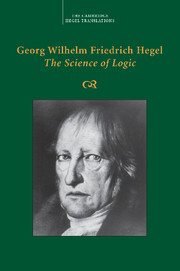Chapter 3 - Teleology
Published online by Cambridge University Press: 30 September 2021
Summary
Where there is the perception of a purposiveness, an intelligence is assumed as its author; required for purpose is thus the concept's own free concrete existence. Teleology is above all contrasted with mechanism, in which the determinateness posited in the object, being external, is one that gives no sign of self-determination. The opposition between causæ efficientes and causæ finales, between merely efficient and final causes, refers to this distinction, just as, at a more concrete level, the enquiry whether the absolute essence of the world is to be conceived as blind mechanism or as an intelligence that determines itself in accordance with purposes also comes down to it. The antinomy of fatalism, along with determinism, and freedom is equally concerned with the opposition of mechanism and teleology; for the free is the concept in its concrete existence.
Earlier metaphysics has dealt with these concepts as it dealt with others. It presupposed a certain picture of the world and strived to show that one or the other concept of causality was adequate to it, and the opposite defective because not explainable fromthe presupposed picture, all the while not examining the concept of mechanical cause and that of purpose to see which possesses truth in and for itself. If this is established independently, it may turn out that the objective world exhibits mechanical and final causes; its actual existence is not the norm of what is true, but what is true is rather the criterion for deciding which of these concrete existences is its true one. Just as the subjective understanding exhibits also errors in it, so the objective world exhibits also aspects and stages of truth that by themselves are still one-sided, incomplete, and only relations of appearances. If mechanism and purposiveness stand opposed to each other, then by that very fact they cannot be taken as indifferent concepts, as if each were by itself a correct concept and had as much validity as the other, the only question being where the one or the other may apply. This equal validity of the two rests only on the fact that they are, that is to say, that we have them both.
- Type
- Chapter
- Information
- Georg Wilhelm Friedrich Hegel: The Science of Logic , pp. 651 - 669Publisher: Cambridge University PressPrint publication year: 2010

